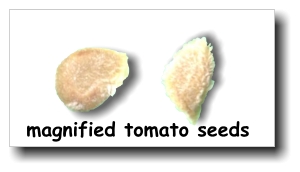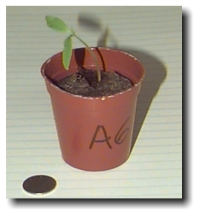|
A seed may be defined as an embryonic plant in a state of arrested
development, supplied with food materials, and protected by one or
more seed coats.
It is able to remain alive, although dormant, through conditions
which may be unfavourable for immediate growth. When suitable
conditions occur a seed will begin to germinate.
Sleeping Seeds

|
Relatively few seeds will sprout as soon as they mature.
Even under ideal conditions most seeds remain dormant for what
is called a "rest period", which varies in duration
in different plant groups. Rest periods are thought to be
necessary for certain chemical changes related to the
"ripening" of the foods stored in the seed.
Seeds, though dormant, are living organisms and need
favourable conditions to grow.
|
How Long Do They Live?
Several factors contribute to the life expectancy of a seed. The
length of time a seed will remain viable (that is, able to sprout
strongly and produce sturdy seedlings) varies widely with the species
and the care taken in harvesting and storing the seeds. Some seeds
(e.g., chervil), rarely retain their germinating power longer than one
year. Other seeds, such as celery, cabbage, cucumber, and various
other vegetables and flowers, may sprout well when ten years old or
even more. Seeds not fully mature when gathered or stored before fully
dry, or kept at too high a temperature, may sprout very poorly or not
at all.
Travelling Seeds
Seeds vary widely in shape and size. The seeds of the begonia, are
almost dust-like. Seeds of the "double coconut" may be 30 to
45 centimetres long and have masses up to 20 kilograms. Seeds also
exhibit a marvelous diversity of form. In many cases the shape and
size of the seed is a special adaptation to assist in its
distribution. Some seeds, such as the "wings" of the maple
tree and the "parachutes" of dandelions and milkweeds, are
adapted for wind transportation. Other seeds use burrs and hooks, to
attach themselves to animals. Some seeds, such as those of the tomato
and blackberry, have impervious coats which enable them to survive
digestion in animals' stomachs; while others are suited for
transportation by water, by being buoyant and waterproof for long
periods of time.
Conditions Necessary for Germination
1. Preconditioning
Some seeds require specialized "pre-conditioning" before
they will germinate. Some examples include:
- alternate freezing and thawing may be required to break down and
crack hard shells
- a dormant period of "rest" in cool dry conditions may
be required by some seeds
- ponderosa pine seeds must be "singed" by the heat of
forest fires before they are able to germinate;
- the seeds of the Calvaria tree (native to Madagascar)
must be passed through the intestinal tract of turkeys before they
are able to germinate
- in the presence of red light and infrared light
some seeds, such as tomato seeds, are known to produce bioactive
chemicals called gibberellins (GAs) which promote seed
germination. In dicotyledenous plants (that is, plants whose seeds
have two embryonic leaves), dicots for short ,
such as the tomato, the GA promotes the growth potential of the
embryo and weakens the structures surrounding the embryo.
2. Moisture
Seeds tend to remain dormant as long as they are dry. Water softens
the seed coat and expands the protoplasm.
3. Oxygen
All green plants need oxygen to "breathe" or respire.
Like humans, they need oxygen to live and grow. However, dormant seeds
need little oxygen.
4. Warmth
- Minimum: Tomato plants will not germinate at temperatures
below 10°C.
- Optimum: Tomato plants germinate best between 17°C and
20°C.
- Maximum: Tomato plants will not germinate at temperatures
which exceed 35°C.
Germination

|
Seeds are protected by a hard shell or seed coat. This
shell can be extraordinarily tough. Some seeds require that
they be eaten by animals to soften the seedcoat and permit
germination. For others, simply soaking the seed in warm water
will soften the seed coat enough to allow the seed to begin to
germinate.
In nature suitable conditions are provided by climate and
weather. In agriculture the correct conditions can be
simulated in greenhouses and "hot beds".
|
|
|

|
Hidden inside every seed is a tiny embryonic plant complete
with root, stem and leaves, ready to sprout when suitable
conditions appear.
The seed's plant-parts are not "true" leaves,
stem and roots, but are effective enough to launch the plant
into its growth phase when true leaves, roots and stems
appear.
Flowering plants whose seeds have one embryonic leaf
(cotyledon) are called monocotyledons. Flowering plants whose
seeds have two cotyledons are called dicotyledons.
Tomato plants are dicotyledons.
|
|

|
When warmth, water, and oxygen become available a seed
begins to germinate. The embryonic plant begins to grow and
the seed coat swells and breaks open under the pressure of the
growing seedling within the shell.
Before photosynthesis begins the spouting plant uses food
stored within the seed to grow.
As long as the environmental conditions remain favourable
the plant will continue to grow, the stem and the cotyledon(s)
pushing upwards and the root(s) extending downwards.
|
|

|
As the emerging seedling begins to grow its dependence on
stored food diminishes and the transition to its own
photosynthetic food production begins. It will not survive
unless ample light is added to the water, warmth, and oxygen
needed for germination.
|
|
At what point can we say
that germination has been successful?
In the Tomatosphere project we are dealing primarily
with tomato seed germination. Germination is, of course, a process
whose duration varies according to the type of seed and
the local environmental conditions to which the seed is
exposed.
Our interest is in both the rate (time), and the success,
of tomato seeds in the germination process.
|

New tomato seedling
approximately one week beyond the "successfully
germinated " point. |
In order to ensure, as much as possible, the
self-consistency of all observations made by numerous
independent observers, the following criteria will be used to
define the condition "successfully germinated".
For purposes of this experiment, a seed can be
considered to have successfully germinated when two (2)
distinctly separate cotyledons (embryonic leaves) can be
seen.
|
|






